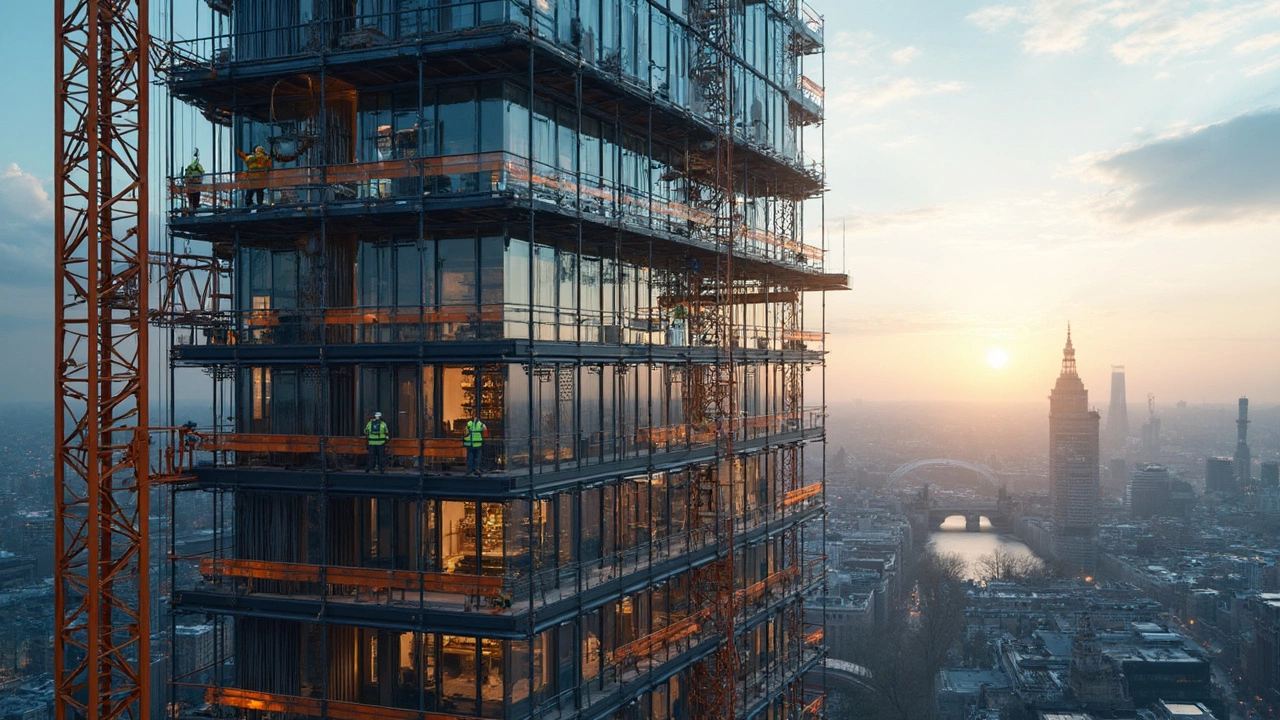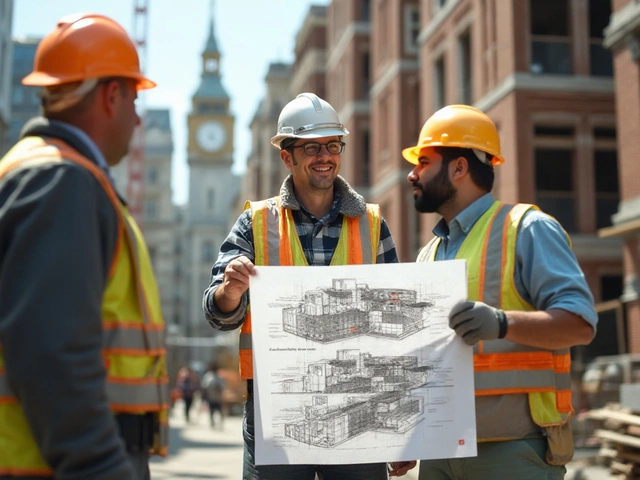Ever wonder what those tiers mean when you’re looking at building contractors? Well, there's a lot more to it than just numbers and ranks. The tiers in the contractor world are like a shorthand for understanding their capability and the kind of projects they handle.
Starting with the basics, Tier 1 contractors are the big fish. They take on mammoth projects that usually come with colossal budgets. Think skyscrapers, complex infrastructure, or large commercial buildings. They've got a big reputation to manage and pull it off because they have the experience, resources, and workforce.
Tier 2 contractors? They're like the medium-sized enterprises. They take on projects that are significant but not at the mammoth level. These guys might be building schools, medium-sized office spaces, and other mid-range tasks. They strike that perfect balance between capability and specialized attention, making them a popular choice for many common builds.
- Defining Contractor Tiers
- Characteristics of Tier 1 Contractors
- Inside Look at Tier 2 Contractors
- Exploring Tier 3 Contractors
- Choosing the Right Tier for Your Project
Defining Contractor Tiers
When it comes to building contractors, the tier system is a handy way to break down different levels of expertise, project types, and resources. It's less about ranking in superiority and more about matching the right contractor to the right type of project.
What Are Tiers?
Basically, the tiers help categorize contractors based on size, capability, and experience. It ensures that projects are handled by firms that have the appropriate skill set and manpower. Think of it like matchmaking in the world of building projects, which is kinda neat!
Breaking Down the Tiers
- Tier 1 Contractors: These are the big leagues. We're talking about firms that have vast resources at their disposal. They tackle complex, large-scale projects, such as airports, stadiums, and massive commercial buildings. Their roles often involve not only execution but also substantial planning and design input.
- Tier 2 Contractors: Right in the middle, these contractors focus on mid-sized projects. They often work on things like schools and smaller commercial spaces. Their dual strength lies in being able to handle significant challenges while offering more personalized approaches compared to Tier 1 giants.
- Tier 3 Contractors: These are more localized outfits. They focus on smaller scale projects like residential buildings or small businesses. Basically, projects where nimbleness and close-knit communication can really make a difference.
The Importance of Choosing the Right Tier
Picking the right tier is crucial. It can impact timelines, costs, and ultimately, the success of your building project. Imagine having a Tier 1 contractor for a small home renovation—kind of overkill, right? Likewise, giving a gigantic infrastructure project to a Tier 3 firm might not end well in terms of efficiency and expertise.
Using the tier system allows clients to gauge what kind of service they can expect and align those with their project's requirements. This helps in resource allocation, budgeting, and setting realistic expectations.
Characteristics of Tier 1 Contractors
When it comes to building contractors, Tier 1 is where the heavy hitters hang out. These are the industry's giants, equipped to manage the most complex and high-budget projects. So, what sets them apart from the other tiers?
Size and Scale
First off, Tier 1 contractors operate on a much larger scale than their peers. They tackle giant undertakings like infrastructure projects, major commercial developments, and even entire new towns. It’s not just about the size though. These projects often come with lots of moving parts and require a vast array of skills and resources.
Expertise and Resources
To handle such demanding tasks, Tier 1 contractors have to have an unmatched level of expertise. This means employing top-tier engineers, project managers, and a skilled workforce. They also have access to advanced technology and equipment that smaller contractors simply can't afford.
Financial Might
Ever wonder how they can deal with projects worth millions, or even billions? It's all about the financial muscle. Tier 1 firms often have the financial backing, including credit lines and capital reserves, making them resilient against the financial constraints that might cripple smaller firms.
Global Reach
Many Tier 1 contractors aren't limited to just one country. They have footprints in multiple regions and can handle projects in different parts of the world. This global reach not only expands their business but also allows them to draw from a diverse pool of knowledge and experience.
Here's a small set of numbers to give you an idea:
| Attributes | Details |
|---|---|
| Average Project Size | $100 million and above |
| Employee Count | 10,000+ |
| Presence | International |
| Specialization | High Complexity Projects |
With all this, it's no surprise that Tier 1 contractors are the go-to for governments and corporations looking for reliable partners in massive and strategically critical projects. If you're dealing with a project of this scale, knowing you have such a powerhouse at your side can be extremely reassuring.

Inside Look at Tier 2 Contractors
Tier 2 contractors fill an important niche in the building industry. They're like the best of both worlds, offering robust services without the massive overhead that often accompanies Tier 1 players. These contractors are typically geared towards mid-sized projects, making them an ideal choice for a lot of common construction needs.
Project Types and Examples
Unlike the colossal constructs by larger firms, Tier 2 contractors usually tackle projects such as regional shopping centers, townhome complexes, and schools. This tier especially excels in handling projects that require detailed attention yet are bigger than what a small team could manage.
Key Characteristics
- Adaptability and Flexibility: While not as large as Tier 1, these contractors are highly adaptable to varying project requirements.
- Cost-Effectiveness: They often provide a more affordable solution without compromising quality.
- Relational Approach: Tier 2 often emphasizes stronger client relationships due to the nature and scope of their projects.
It's this blend of features that makes Tier 2 a common choice. They're just big enough to ensure professionalism while staying small enough to offer personalized service.
Resources and Workforce
These companies usually have fewer than 250 employees but are backed by a reliable network of subcontractors. This setup allows them to maintain a lean operation while still scaling for larger endeavors. Their ability to efficiently manage resources means project timelines are often smoother and more predictable.
Recent Trends
There's been a notable rise in Tier 2 projects focusing on sustainability. More clients demand eco-friendly building standards, and Tier 2 contractors are stepping up to meet these needs without bursting budgets.
Choosing a contractor should never be a hasty decision. If your project falls within the sweet spot of medium-sized jobs that require detailed oversight and personalized service, Tier 2 contractors might just be the perfect fit for you.
Exploring Tier 3 Contractors
If you're working on your home or a small local project, chances are you're looking at Tier 3 contractors. These folks are the backbone of the residential and small commercial construction. They're the ones handling your neighborhood store, small office renovations, or even that dream house down the street.
What Sets Tier 3 Contractors Apart?
One of the striking things about Tier 3 is their specialization in smaller-scale projects. They're experts at dealing with limited budgets and timelines, which means they're pretty flexible with their working style. This tier generally consists of small to medium-sized companies, often offering a more personal touch compared to the biggies.
Advantages of Choosing a Tier 3 Contractor
- Personalized Service: With a less corporate vibe, you're more likely to speak directly with the owner or manager, ensuring your needs are fully understood.
- Affordability: Focusing on competitive pricing, they often offer better value for smaller projects.
- Local Expertise: Familiarity with local regulations and conditions is a big plus, especially for specific regional quirks.
While Tier 3 contractors excel in smaller jobs, they also face challenges, like limited manpower and resources. But their ability to adapt and customize solutions often compensates for this.
Stats to Consider
Did you know that in many regions, Tier 3 businesses make up more than half of the market for construction work? They might not have the flashiness of the top-tier firms, but their impact is huge.
So, whether it’s your kitchen remodel or adding another story to your home, considering Tier 3 contractors could be your best bet. They're often driven by reputation and word-of-mouth, ensuring that your project gets the care and attention it deserves.

Choosing the Right Tier for Your Project
Picking the right building contractors tier can feel like a big decision, but it really comes down to understanding what your project needs and matching it to the contractor's capabilities. Let's break it down and make it easier.
Evaluate the Project Scope
The first step is to understand what your project entails. Is it a straightforward home renovation, or are you looking at something more extensive like a commercial building? If you're working on a huge scale, a tier 1 contractor is a no-brainer. They have the resources and experience to handle all the complexity that comes with large projects.
Budget Considerations
Your budget plays a critical role in deciding which tier suits your project. Tier 1 contractors generally come with a hefty price tag due to the scope of their work and their expertise. For projects that demand quality but come with middle-range budgets, tier 2 contractors could provide a perfect balance between cost and skill.
Consider the Project Timeline
How quickly do you need the project done? Tier 1 firms typically have massive teams and can manage faster turnarounds, while tier 3 contractors may take a bit longer due to smaller crew sizes. Balance your needs with your timeline to make the right call.
Complexity and Specialization
If your project requires specific expertise or sophisticated design elements, higher tiers might offer a broader range of specialized skills. However, if it's a simpler job, Tier 2 or 3 contractors could handle it effectively for a lesser cost.
Local Market Examples
Sometimes, local insights can impact your choice. For instance, in major urban areas, there's a prevalence of experienced tier 1 contractors available for big builds.
Contractor Availability
Here's a fun fact: Did you know that in 2024, a study showed that tier 2 and 3 contractors were in higher demand than tier 1 due to increasing residential and mid-sized commercial projects? It's something to keep in mind while you plan.
| Tier | Typical Projects | Cost Range |
|---|---|---|
| Tier 1 | Skyscrapers, Malls | High |
| Tier 2 | Schools, Office Buildings | Mid to High |
| Tier 3 | Home Renovations | Low to Mid |
In the end, the right choice depends on carefully analyzing these factors. Matching your project's requirements with a contractor's strengths can save time, money, and potential headaches down the line.





